Foreign Insulators
by Marilyn Albers
Reprinted from "Crown Jewels of the Wire", April 1994, page 14
THE INSULATOR COLLECTING HOBBY IS GROWING!
Part II: "New Insulator styles, colors and markings found in Australia
and New Zealand"
Many thanks to all who let me know how much they enjoyed "meeting"
the insulator collectors from Australia and New Zealand in Part I of this
article printed in the February '94 Crown Jewels. Though not all of them
subscribe to the magazine, each of those families now has a copy of that
particular issue, and they are pleased, too.
Most of the collectors we met limit
themselves to pieces they know were produced or at least used in their own
countries. Aren't many of us like that, too? But still they enjoy the variety of
adding a few insulators from other lands if the colors and shapes are
interesting. We noticed several eyes popping as we unwrapped the carnival glass
pieces we'd agreed to bring to one collector. Since our arrival back in the
States, some of the others have written to request more of this beautiful glass.
It will be a pleasure to find it for them!
Bill and I were privileged to see
several outstanding insulator collections, including several rare and unique
specimens. Due to limited space, only a few of them are shown in photographs.
For proper identification of other CD and U-numbers mentioned, and for the
benefit of new collectors, please refer to the scale drawings at the end of this
article. And when collectors names are mentioned here, you will want to go back
and find their pictures in the February '94 issue.
During our short visit with
Richard Edmonds in Sydney, he showed us two examples of CD 423 A.G.M. in medium
amethyst, which is a very rare color for this style. And though very few have
found their way to collections in North America, Richard has had good luck and
has found seven of them while out walking the lines. Three other Australian
collectors were happy to have just one! Most examples are in excellent
condition.
Warren Foster of East Kurrajong, New South Wales has discovered
several interesting porcelain insulators, including a putty colored U-1500 with
the word "MELBOURNE" incused in tiny letters across the top of the
crown. Collector Mike Hornabrook has reason to believe it is a product of the Melbourne Pottery Company, possibly dating back to 1895.
Another of Warren's discoveries was a U-1503 marked "CLARK MUIRHEAD &
Co. LTD WESTMINSTER" on the skirt, identifying the contractor rather than
the maker. This company was in business as early as 1875. Truly a rare find! He
also had a U-1452 with "NGK (logo) JAPAN No.1" ink stamped on the side
of the crown. Very interesting to note that Australia imported the Cordeaux
style from Japan as well as from Great Britain.
We fell in love with the tiny
little white bells you see below. For the moment, they are both classified as
U-1101, even though there are slight differences between the two. The one on the
left has a normal pin hole for this size insulator, but no inner skirt. The
other has a tiny pin hole and just the barest excuse for an inner skirt. It's
possible that each was made by a different manufacturer, though neither is
marked. This little munchkin is not plentiful by any means, but several
collectors in Australia seemed to have at least one specimen.
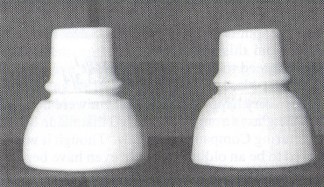 |
Two examples of
U-1101
2 x 2- 1/8 |
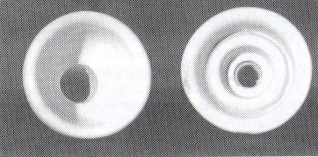 |
Picture below shows the interior differences of the
U-1101 |
Lucas Wollaston of Delamere, South Australia showed us some shining examples
(literally) of unembossed CD 121' s in clear, pink tint and deep amber. These
are some of the earliest insulators made by the A.G.M. Company of Sydney, and
these shades of color are the hardest to find, especially in mint condition. He
also had an absolutely mint CD 154 "AGEE" in the prettiest, darkest
purple I have ever seen in my life! Another interesting piece Lucas had was a
white U-1491. This style is quite common locally, but the marking is unusual.
The letters "D.B.S." are enclosed within a tiny map of Australia and
incused on the top of the crown.
Gail and Noel Dawson of Grovedale, Victoria
have really gone into collecting Australian insulators big time! They have many
treasured pieces and have taken down just about all of them. One caught my eye
immediately. It was a CD 1055 spool embossed "A.G.M. L.T.O.l." Nothing
unusual about that, you say? Right, and I'd agree if it had been the normal
straw color, but this one was bright yellow green! An absolutely gorgeous piece!
The really big news is that they had discovered a new glass pintype and were
able to take it right off an abandoned line. It was rather plain actually, in
that it was not embossed and the color was a dull grayish mauve, but it was a
new style and it was a super find just the same.. I was able to make a shadow
profile, get the measurements and snap the photo you see below . Working from
this information alone, Woody agreed to give it a new CD assignment, bless him.
And the Dawsons were very happy to hear it. There were no clues as to a
manufacturer, but the glass strongly resembled that made by the Australian Glass
Manufacturing Company of Sydney. Though it was in good condition, it appeared to
be an oldie and could even have been an experimental piece.
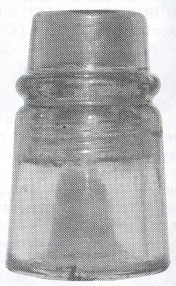
CD 420.1
2- 3/8 x 3- 3/4
Brian Woodman of
Corio, Victoria told us about a blue aqua CD 121 he has seen with the letters
P.M.G. embossed on the skirt. I do have some historical background on this piece
and an actual photo of it, which I'll share with you in the May issue of Crown
Jewels.
Mike Hornabrook of Edenhope, Victoria, had more of his collection
outside the house than inside. His most treasured pieces were on shelves right
by the front door so there was no way to miss them. (How's that for educating
your friends about insulators?) Among the insulators was a white U-2070A, fondly
referred to as a "noser'. Though unmarked, it was a really unique piece,
and one he had obtained through a trade with Gail Dawson. Apparently these were
used in the Geelong area, around the bay from Melbourne. This style was very
likely a Czech import, as many examples were made and used in that country from
1920 through 1950. Mike also showed me an example of U-1148 with an unfamiliar
marking stamped in blue ink on the skirt. The date (19) "49" followed
by the letters "MB" and "MADE IN JAPAN" were enclosed in an oval
trademark. He had another interesting porcelain in his display, but this one was
chained to the shelf! It was an unmarked U-1491 in a most unusual olive green glaze. It was the first time I'd seen one like this.
Mike will never have to worry about his collection outgrowing the space he has
to put it. There are huge piles of insulators everywhere you look outside, by
the fences, under trees, in the barn, etc. I dream of things like this.
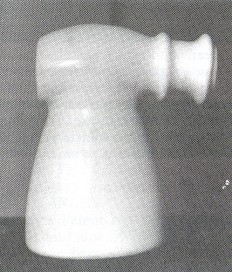
U-2070A
2-1/4 x 3-5/8
Kieran Shanahan of Browns Bay, near Auckland, New Zealand, had the whole
basement of his house filled with his many collections, and insulators occupied
a large part of the space! Bill and I could have spent hours just looking and
looking, each time finding something we missed before. I was very happy to see
an actual specimen of CD 344, which until now we only seen as a drawing in the
Pilkington catalog. We didn't know anyone who actually had one and weren't sure just where they were used. Now at least we knew they were in Australia. This
insulator had a copper covered crown and sandblasted on the upper shell was the
marking "ARMOURLIGHT/56/742/1.56". The glass color was light yellow
green and it was a beautiful piece!
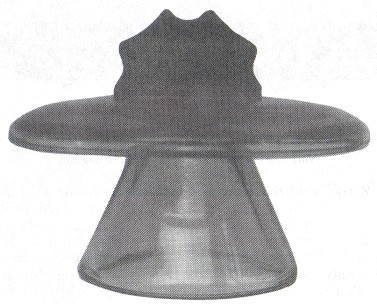
CD 344 "ARMOURLIGHT"
10-1/2 x 6- 1/2 x 8
Kieran had found a most unusual porcelain
"hat" style with a brown salt glaze. It was very crudely made and as
the photo shows, the skirt and petticoat were very thin and fragile. The piece
was unmarked and the maker unknown. Word of his discovery had spread to
Australia and we were told that we must ask to see it when we went to visit
Kieran. Apparently, it is the only one of its kind in captivity.
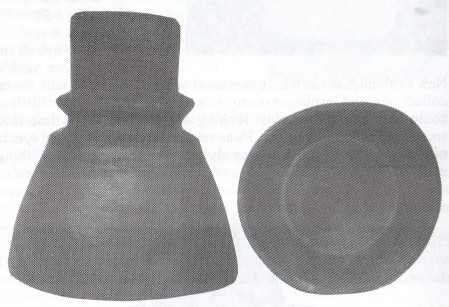
U-1503
4-1/2 x 5-1/4
Note the crude base (right) on the U-1503
Kieran's other discoveries included about six U-1364's in a brown salt glaze,
all identical in size and style to the familiar Varley's Patent No.8, so widely
used in England. These new finds were still cemented to metal pins. One had the
marking "JOHNSON AND NEPHEW MANCHESTER" incused on the dome, and the
others were marked simply "JOHNSON". Mike Hornabrook has also found
one of these insulators in Australia. This was exciting to me because it was a
missing piece of the puzzle! Back in the November 1992 Crown Jewels, Morgan
Davis reported that parts of a brown salt glazed threadless porcelain had been
found by Philip Ort of Ontario, Canada. A piece of the dome was marked
"JOHNSON MANCHESTER". Morgan reported that the insulator was a product of the original Johnson company now
known as Johnson Brothers of Manchester, England, makers of the dishes some of
us have on our dinner table.
New Zealand used a surprising number of British
insulators! Another treasured insulator Kieran found was similar to the U-1364,
but larger. This too had a brown salt glaze, but was marked "4" (over)
"VARLEY'S PATENT", or Varley's Patent No.4, a size unknown until now.
Why haven't any of these been found in England? Were they made only for export
to New Zealand or have they been used in other countries? At this time, there is
only one example of this insulator known and it will definitely be assigned a
new U-number. Kieran is holding kin the photo below.
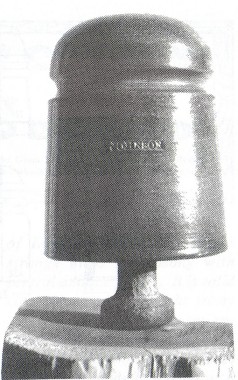
U-1364 "JOHNSON" 3 x 4- 1/8 |
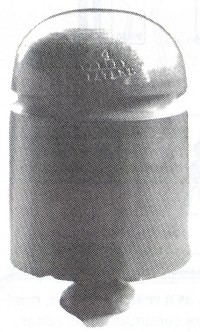
"V ARLEY'S PATENT (No.) 4"
3- 3/8 x 4- 1/2 |
We all tend to think that most of the scarce and desirable insulators are
stowed away in collections, and few are left to find. But that theory gets blown
to bits when you visit a different country and realize that we have only seen a
fraction of what is still out there, just waiting to be discovered. Thus the
attraction of foreign insulators! I must thank Laura Monckton, Brian Woodman,
Mike Hornabrook and Kieran Shanahan for sharing information on some of these old
companies.
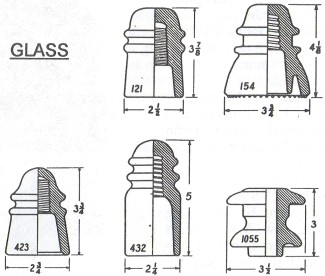
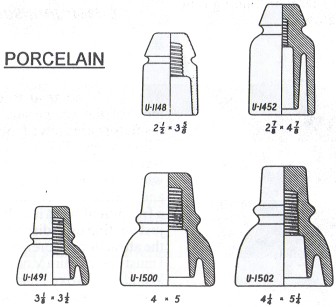
| CJ HISTORY: Foreign Insulators, as a regular column,
originated in July 1979. Marilyn Albers continues as its editor. |
|
